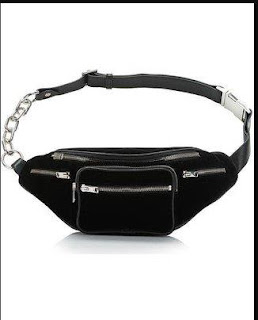On November 16th, AW Licensing, LLC (which appears to be Alexander Wang's trademark holding company and owns several
ALEXANDER WANG trademark registrations) filed a federal trademark application with the
U.S. Patent and Trademark Office for the
fanny pack design seen below (e
d. - are fanny packs back in?). AW Licensing filed the application in Class 25 for "fanny packs." According to the application, Alexander Wang has been selling these fanny packs since December 15, 2016.
The application describes the trademark as "a five-zipper and chain design on a fanny pack." Note that the dotted lines help show where the trademark appears on the product but are not actually considered part of the mark.
TMEP 1202.02(c)(i)(B). In other words, this application does not cover the entire fanny pack, just the placement of the chain and zippers. The specimen of use submitted with the application, showing how this fanny pack appears to consumers, is below.
Technically, this application is for "trade dress," which is generally defined as the "total image and overall appearance of a product" and "may include features such as size, shape, color or color combinations, texture, [and] graphics."
TMEP 1202.02;
Two Pesos, Inc. v. Taco Cabana, Inc., 505 U.S. 763, 764 n.1 (1992). As I've blogged about
before, trade dress can be registered if it is (1) non-functional and (2) inherently distinctive or has acquired distinctiveness in the marketplace.
Generally, trade dress is functional if it is "essential to the use or purpose of the article or if it affects the cost or quality of the article."
TMEP 1202.02(a);
Qualitex Co. v. Jacobson Prods. Co., 514 U.S. 159, 165 (1995) (quoting
Inwood Labs., Inc. v. Ives Labs., Inc., 456 U.S. 844, 850, n.10 (1982)). In considering whether trade dress is functional, the following factors are considered:
- the existence of a utility patent that discloses the utilitarian advantages of the design sought to be registered;
- advertising by the applicant that touts the utilitarian advantages of the design;
- facts pertaining to the availability of alternative designs; and
- facts pertaining to whether the design results from a comparatively simple or inexpensive method of manufacture.
TMEP 1202.02(a)(v).
If the trade dress is not functional, it must be inherently distinctive or have acquired distinctiveness in the marketplace.
TMEP 1202.02(b). In a 2000 Supreme Court case, the Supreme Court stated that trade dress related to product designs (such as this fanny pack), as opposed to trade dress for product packaging, is never inherently distinctive.
Wal-Mart Stores, Inc. v Samara Bros., 529 U.S. 205, 215 (2000). Proving acquired distinctiveness, at least in the product design context, requires a great deal of evidence that shows the product design identifies not only the goods, but the source of those goods. See
TMEP 1212 et seq. In other words, Alexander Wang will need to convince the Trademark Office that when consumers see the "five-zipper and chain design" on a fanny pack, they recognize that fanny pack as an Alexander Wang fanny pack.
What do you think? Is the five-zipper and chain design essential to the use or purpose of the fanny pack? Does it affect cost or quality? Does Alexander Wang tout the utilitarian advantages of five zippers? Are there other alternatives for designing a fanny pack? If the design is not functional, do you recognize Alexander Wang as the designer when you see this fanny pack because of the zipper and chain design?
We'll see what the Trademark Office thinks in approximately three months when this application is assigned to an examining attorney.






